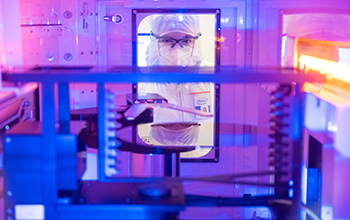NSF announces $10 million partnership with Intel Corporation to train and build a skilled workforce
September 8, 2022
Today, the U.S. National Science Foundation announced an endeavor with Intel Corporation to educate and train the nation's semiconductor manufacturing workforce and advance opportunities for equitable science, technology, engineering and mathematics education. Following the historic passage of the "CHIPS and Science Act," Intel and NSF will invest $10 million to provide funding to support the development of a high-quality manufacturing workforce at all levels of production and innovation as described in a new Dear Colleague Letter, or DCL.
A nationwide shortage in semiconductors, complicated by the global pandemic, has made it difficult for the chip industry to meet the increasing demand for chip-based products. And while that demand is high in the U.S., only about 10% of the global supply of chips is produced nationally. Awards made through this DCL will help tackle this problem by supporting the education and training of the semiconductor manufacturing workforce in the U.S.
"We are thrilled to continue our partnership with Intel to support research and workforce development to advance semiconductor design and manufacturing," said NSF Director Sethuraman Panchanathan. "It's not just about chips — it's about unlocking investments in America's science and technology research, STEM education and workforce. This collaboration presents a remarkable opportunity for students entering this field."
Through this collaboration, NSF and Intel will invest in a wide range of innovations that enhance engineering technology and advanced education and training for semiconductor manufacturing and design. Moreover, it will improve and make more equitable STEM education at two-year colleges and four-year universities, including minority-serving institutions.
"This partnership is important and timely," said James L. Moore III, NSF assistant director for Education and Human Resources. "There is an immediate need to advance semiconductor manufacturing education, research and design in the United States. Given the recent signing of the 'CHIPS and Science Act,' American semiconductor research and production are likely to increase over the next five years. There is also strong national support for investing in STEM education to prepare students entering this field."
"NSF and Intel have a long history of successful partnerships," said Erwin Gianchandani, assistant director for Technology, Innovation and Partnerships, NSF's newest directorate. "This joint investment will advance innovative and evidence-based practices in the education and preparation of the domestic-skilled semiconductor industry technical workforce. And together, NSF and Intel will jumpstart bold and transformative activities that will address immediate semiconductor manufacturing challenges and workforce shortages in the U.S."
"This new program will provide increased opportunities in higher education for students from historically underrepresented groups and help foster a diverse semiconductor manufacturing workforce across the country," said Gabriela Cruz Thompson, Intel Labs senior director of university research and collaboration. "We look forward to continuing our longstanding partnership with NSF to support STEM education at two-year colleges and four-year institutions and expanding the skilled technician and engineering workforce."
This DCL is one part of a previously announced 10-year collaboration between NSF and Intel that will, over time, invest $100 million to address semiconductor design and manufacturing challenges and workforce shortages around the country.
Projects funded through this DCL will focus on semiconductor industry workforce development for high-technology fields that are critical to future semiconductor design and manufacturing. Those interested can apply for award opportunities through two NSF programs: the Advanced Technological Education program, which supports the education of the skilled technical workforce at the undergraduate and secondary school levels; and the Scholarships in Science, Technology, Engineering, and Mathematics program, which supports institutions of higher education to fund scholarships for academically talented, low-income students.
For more information about this partnership and DCL, visit nsf.gov.
The U.S. National Science Foundation propels the nation forward by advancing fundamental research in all fields of science and engineering. NSF supports research and people by providing facilities, instruments and funding to support their ingenuity and sustain the U.S. as a global leader in research and innovation. With a fiscal year 2023 budget of $9.5 billion, NSF funds reach all 50 states through grants to nearly 2,000 colleges, universities and institutions. Each year, NSF receives more than 40,000 competitive proposals and makes about 11,000 new awards. Those awards include support for cooperative research with industry, Arctic and Antarctic research and operations, and U.S. participation in international scientific efforts.
Connect with us online
NSF website: nsf.gov
NSF News: nsf.gov/news
For News Media: nsf.gov/news/newsroom
Statistics: nsf.gov/statistics/
Awards database: nsf.gov/awardsearch/
Follow us on social
Twitter: twitter.com/NSF
Facebook: facebook.com/US.NSF
Instagram: instagram.com/nsfgov

